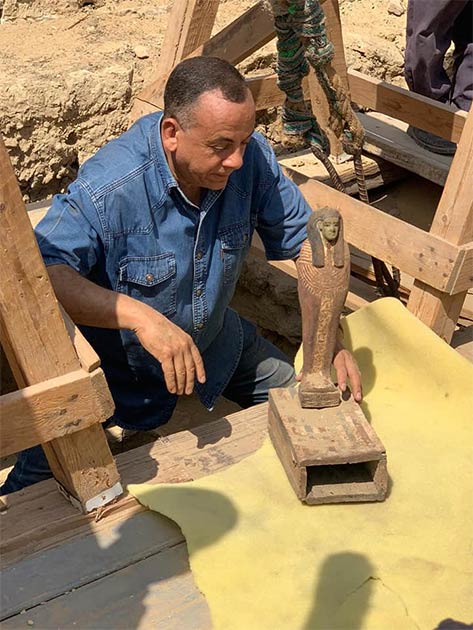Egypt’s Ministry of Antiquities announced today (Sunday 20 Sept) that archaeologists digging in the animal necropolis at Saqqara have discovered 14 well-preserved painted coffins dating back 2,500 years, in a surprise discovery which they say is “only the beginning”, hinting that there is a lot more to come!
The 14 newly identified highly-decorated ancient wooden coffins were discovered within the shadows of a 2,500-year-old, 11-meter deep, burial well at the ancient-Egyptian sacred animal necropolis at Saqqara. It was here, at this same well, where only two weeks ago Ancient Origins covered the discovery of “ at least” thirteen ancient burials, and the first photographs of the newly discovered 14 wooden coffins show, similarly to the first 13, intricately executed hieroglyphs and painted scenes using deep-maroon and blue paints.
Khaled Al-Anani, head of the Egyptian Ministry of Tourism and Antiquities , announced in a Facebook post on 8 September that a team of archaeologists had identified 13 well-preserved ancient wooden caskets, and that their original colors were intact, offering researchers new insights into Egyptian burial traditions and associated rituals. However, what confused archaeologists at this excavation site was that they found the 13 ancient burial boxes “stacked on top of each other,” in an enclosed burial well measuring about eleven meters deep, at the Saqqara archaeological zone, an arm of the ancient capital of Memphis, classified as a UNESCO World Heritage Site in 1979.
A Site With As Much Below, As Above Ground
The ancient Saqqara royal necropolis is located about 30 kilometers (19 mi) south of modern-day Cairo at the prehistoric Egyptian capital of Memphis, and hundreds of ancient tombs with magnificently colorful inscriptions lie beneath the foundations of the colossal rectangular-based Step Pyramid of Djoser, vast stone temples and cult shrines. And it was here, buried beneath ruins at Saqqara, that archaeologists discovered the first thirteen stacked human coffins, and now another 14 have been unearthed bringing the total to “27 individual burials” in the ancient well, according a new Facebook post by the Ministry of Antiquities.
It was at this famous royal necropolis and tourist center that in 2018 Ancient Origins announced the discovery of a the 4,400-year-old “Tomb of Wahty,” where 365 ushabti statues, representing the days of the solar year, were found with wooden obelisks surrounding a statue of the god Ptah. It was also at this same burial site in April 2020 that archaeologists unearthed a tomb filled with the remains of hundreds of mummified sacred animals, including a bird cemetery and wrapped up crocodiles, cats and snakes that had all been laid to rest to serve their masters on their way to the afterlife.

One of the ushabti figures pulled from the tomb. Credit: Ministry of Tourism and Antiquities
Wooing Back Tourists with Otherworldly Promises
One evening, somewhere about two a half millennia ago, after the 27th coffin had been lowered into place in the well, a team of High Priests conducted a ritual which culminated in the sealing of the burial shaft, effectively trapping hundreds of ancient artifacts in a time capsule. Two weeks ago, Secretary-General of the Supreme Council of Antiquities Mostafa Waziri said this archeological mission would soon reveal details of their findings, including, the exact number of coffins, as well as the identity and posts of their occupants.” And at that time the total was 13, but this new announcement made today brings the ‘running’ total to 27, meaning the archaeologists have more than doubled their workload, and there really couldn’t a better time for these discoveries to occur.
Tourism in Egypt, like in the rest of the world, suffered terribly through the 2020 coronavirus pandemic lockdowns and over the last six months ancient burial sites in Egypt, like Saqqara, returned to their original functions and became “ghost towns.” However, big announcements such as the discovery of “27 highly-preserved well-coffins” go a long, long way towards encouraging a return of archaeological tourists, who are right now slowly dusting off their boots, polishing their lenses, and booking flights again.
Top image: One of the newly-discovered coffins in Saqqara. Credit: Ministry of Tourism and Antiquities
By Ashley Cowie
Related posts:
Views: 0
 RSS Feed
RSS Feed

















 September 21st, 2020
September 21st, 2020  Awake Goy
Awake Goy  Posted in
Posted in  Tags:
Tags: 
















